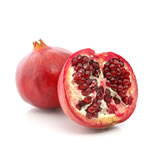Hello all and Happy Friday! It has been a very exciting week with the elections. As we all wind down, let’s dive into next week’s fabulous menus! The greatest part about this time of year is the unique produce. Nothing like their relative produce items, pomegranates and spaghetti squash stand alone in their textures and look. Let’s learn more…
Pomegranates, “The Jewel of Winter”
Pomegranates don’t earn their name for no reason. Their beautiful and vibrant colors set  in little seeds that fill their interior, as you open a pomegranate, it truly does look like a jewel. While they can be a little messy, a little tricky, and seemingly too much work to enjoy, follow these tricks to make the most out of these gems.
in little seeds that fill their interior, as you open a pomegranate, it truly does look like a jewel. While they can be a little messy, a little tricky, and seemingly too much work to enjoy, follow these tricks to make the most out of these gems.
The best way – and it’s proven – to dig out these delicious seeds, according to Carolyn, is to fill the sink or a deep bowl with water, cut the fruit in half and immerse it in the water.
This softens the white pith holding the seeds and allows you to gently coerce them from the membrane without destroying any of the precious seeds!
Carolyn’s sister did this last week and it worked really well. There were enough seeds to almost fill a quart size zip lock bag.
Pomegranate Factoids
According to Health Diaries:
- The pomegranate is native to Iran, Saudi Arabia, Northern India, Bengal, and Southern Asia and is cultivated widely throughout the Middle East, India, southeast Asia, and parts of Africa.
- Many scholars believe it was a pomegranate rather than an apple that tempted Adam and Eve in the Garden of Eden.
- The pomegranate was introduced to California by Spanish settlers in 1769.
- Thomas Jefferson planted pomegranates at Monticello in 1771.
- In Greek mythology, Persephone is condemned to spend every winter in the underworld after the god Hades tricks her into eating pomegranate seeds.
- Every October, the Pomegranate Festival is held in Goychay, Azerbaijan. The festival features pomegranate cuisine, dancing, and music.
Pomegranate Nutrition
According to HealthGuidance.org, pomegranates contain roughly 235 calories per serving (of course pomegranates range in size) and of these 28 are fats and the majorities are sugars. This makes the pomegranate great for energy, but it’s important not to OD on sugars. Those 28 calories make up 3g which is roughly 5% of the pomegranate. There are also 8mg of sodium, 53g of carbohydrates, 11g of dietary fiber, 5 grams of protein and 39 of sugars.
The little jewels can be eaten as a snack, sprinkled on salad and lately I have been seeing several recipes that pair them with sauteed or roasted winter squash. You really can’t go wrong.
 Speaking of squash, next week’s Spaghetti Squash is such a treat! A great substitute for pasta, this delicious stringy squash is awesome!
Speaking of squash, next week’s Spaghetti Squash is such a treat! A great substitute for pasta, this delicious stringy squash is awesome!
How to Cook Spaghetti Squash (according to About.com)
Cooking Spaghetti Squash Whole
Advantages: It’s easier.
Disadvantages: It takes longer to cook, and you need to watch out for burns when removing the pulp and seeds.
Method: Pierce the squash several times with a sharp knife. (Do this especially if you’re microwaving it, or you may end up with a “Squash Explosion.”)
Bake about an hour in the oven at 375 F.
Microwave 10 to 12 minutes, then let stand for 5 minutes or so afterward to finish steaming.
Boil for half an hour or so.
Slow Cooker/Crock Pot: Put it in with a cup of water and let it go on low all day (8 to 10 hours).
When done, cut open “at the equator” (not lengthwise), remove seeds and pulp (I use tongs and an oven mitt — it is HOT) and separate strands with a fork.
Did You Know? Any squash seeds can be roasted just like pumpkin seeds (pumpkin is a kind of squash). They are low-carb, nutritious, and delicious: How To Roast Pumpkin or Squash Seeds
Just about any way you can think of to apply heat can be used to cook spaghetti squash. The big question is: to cut or not to cut before cooking? You can do it either way.




